Commenti / Domande (195)
![]() Rita Kalders ha scritto:
Rita Kalders ha scritto:
Heel mooi jasje ook de uitleg voor het breien 👍 ik zou alleen willen weten of er ook een mutsje is voor erbij te breien
21.03.2024 - 13:59
![]() Kathrin ha scritto:
Kathrin ha scritto:
Tolle Anleitung und wunderschönes Ergebnis. Nächstes Mal würde ich tatsächlich 5cm kürzere Ärmel stricken. Ohne Umschlag würde sie mir besser gefallen. Aber das ist auch Geschmackssache. Vielen Dank für die wunderschöne Jacke!
22.09.2023 - 21:17
![]() Rina ha scritto:
Rina ha scritto:
Maak maat 3/4 jaar. Ben beginner snap heel de alinea v-hals niet sorry Dus 2 naalden alleen de voorbies breien ??? Minderen is ok Meerderen mouw ??? Graag uitleg aub Thx
18.05.2023 - 15:27DROPS Design ha risposto:
Dag Rina,
Ja klopt, alleen over de 6 voorbiessteken. Dus je breit 6 steken, dan keer je het werk en brei je 6 steken terug. Dit wordt gedaan zodat de v-hals als het ware beter om de bocht kan. Dit wordt dus alleen in het begin van de v-hals gedaan. Daarna brei je weer gewoon over alle steken en minder je steken naast de voorbies, zoals beschreven.
24.05.2023 - 21:19
![]() France Cloutier ha scritto:
France Cloutier ha scritto:
Pour la veste grandeur 12-18 mois, je dois monter au début 39 mailles. entre parenthèses, vous indiquez "y compris 6m de bordure et 1m lisière. Est-ce que ça veut dire que les 39 mailles à monter comprennent ces 6 mailles ou bien est-ce que je dois monter 7 mailles supplémentaires avant de débuter?
18.02.2023 - 19:36DROPS Design ha risposto:
Bonjour Mme Cloutier, ces mailles sont comprises dans les 39 mailles à monter, vous n'avez pas besoin de les monter en plus. Bon tricot!
20.02.2023 - 09:45
![]() Maryam ha scritto:
Maryam ha scritto:
Hello, it seems that there is a mistake in the pattern when explaining the pocket. For 6 months old the number of stitches are 35, yet you have written to work 6 garter +22 in pattern +16 on hold+6 remaining stitches which amounts to 50 stitches. Can you explain this to me please ?
12.02.2023 - 21:56DROPS Design ha risposto:
Dear Maryan, the 16 stitches slipped on a thread for the pocket are the last 16 stitches worked on right needle, ie the 16 last of the 22 stitches worked in M.1. Happy knitting!
13.02.2023 - 10:58
![]() Kristin Petersson ha scritto:
Kristin Petersson ha scritto:
Hej Tänker jag fel och var i så fall Ska nu sticka ficka på h framst. Har 35 maskor och ska enl mönstret sticka 6 rätts framkantsm + 22 M1 , 16 m på tråd , 6 m M1 + 1kantm. 6+ 22+16+6+1=51 maskor totalt Förstår inte vart jag tänker fel Tacksam för snabb hjälp
02.02.2023 - 22:37DROPS Design ha risposto:
Hej Kristin, du skal tænke at højre side er din højre side som hvis du selv har koftan på :) (så din högra är den till vänster när du tittar på babyn) :)
03.02.2023 - 11:38
![]() Alison ha scritto:
Alison ha scritto:
When casting on stitches for the sleeves for 12 mo to 18 mo size the pattern says 5 sts 5 times, 7 sts 1 time and then 21 sts 1 time. Surely the last number is a mistake? It would make a very long sleeve ! The sleeve length for a 12 - 18 month old is only 7.5 to 8 inches.
06.01.2023 - 01:53DROPS Design ha risposto:
Hi Alison, You should have 21 stitches on 10 cm in width if your knitting tension is correct. With 53 stitches on the sleeve this gives you a length of 25 cm = 9.8 inches. The sleeves are quite long in this pattern to cover the child's hand if necessary or turn up the bottom edge for a cuff. But you can of course decrease the number of stitches you cast on if you would like a shorter sleeve. Happy knitting!
06.01.2023 - 08:34
![]() Suzette ha scritto:
Suzette ha scritto:
I love this pattern but cannot seem to get the hang of casting off for the V neck. If my first stitch is a purl then I use the decrease tip to P2 tog twisted. This leaves me just one stitch left in that sequence. Now when I get to the next decrease (which is a knit) there is only one knit stitch at the beginning . How do I decrease this stitch if I use the slip, knit, passover then I'm using the first purl stitch in the next grouping? If I do that what do I do on the return row still P2?
05.12.2022 - 19:21DROPS Design ha risposto:
Dear Suzette, you should continue to work the pattern as before, this means work either slip 1 , K1, psso if the stitch should be knitted or p2 tog if the stitch should be purled, so that the double moss stitch is not broken. Happy knitting!
06.12.2022 - 10:57
![]() Manon L ha scritto:
Manon L ha scritto:
Devant droit: Monter par exemple 31 mailles (y compris 6m de bordure devant et 1 m lis sur le côté) pouvez-vous me dire si je dois monter 32 mailles plus 6 plus une maille lisière? Merci
23.11.2022 - 00:57DROPS Design ha risposto:
Bonjour Manon, en fait non car ces mailles sont déjà comprises dans les 31 mailles à monter, autrement dit montez 31 m et tricotez (après 1 rang en mailles envers) ainsi, vu sur l'endroit: 6 m point mousse (= bordure devant), * 2 m end, 2 m env*, répétez de *-* jusqu'à ce qu'il reste 1 m et terminez par 1 m lis au point mousse. Bon tricot!
23.11.2022 - 09:13
![]() Dipti Shah ha scritto:
Dipti Shah ha scritto:
CAN I USE REGULAR NEEDLE INSTEAD OF CIRCULAR ?
04.11.2022 - 12:24DROPS Design ha risposto:
Dear Mrs Shah, sure you can - we use here circular needle to have enough room for all stitches - read more about adapting a pattern into straight needles here. Happy knitting!
04.11.2022 - 13:58
Checco's Dream#checcosdreamcardigan |
|||||||
 |
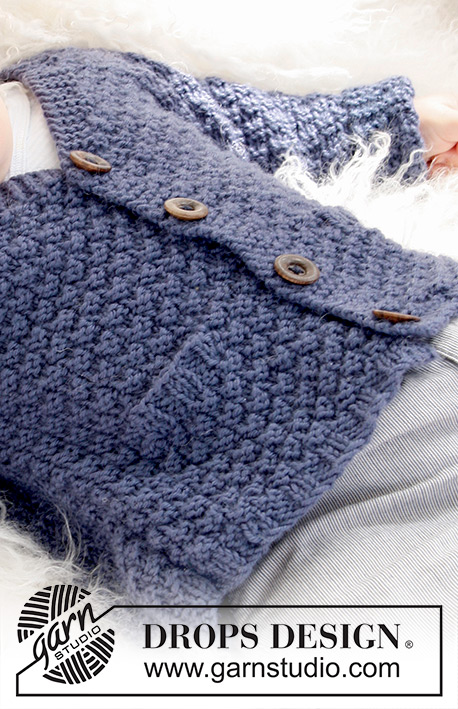 |
||||||
Cardigan lavorato ai ferri con maniche senza cucitura a grana di riso per neonati e bambini in DROPS Merino Extra Fine.
DROPS Baby 21-11 |
|||||||
|
MAGLIA A LEGACCIO (avanti e indietro sui ferri): lavorare a dir. tutti i f. MOTIVO: Vedere il diagramma M.1 – il diagramma mostra il motivo dal diritto del lavoro. ASOLE: Intrecciare per le asole sul bordo davanti destro 1 asola = lavorare insieme a dir. la 3° e la 4° m. dal bordo e fare 1 gettato, sul f. successivo lavorare il gettato a dir. Intrecciare per le asole quando il lavoro misura: Taglia 1/3 mesi: 2, 6, 11 e 15 cm. Taglia 6/9 mesi: 2, 7, 12 e 16 cm. Taglia 12/18 mesi: 2, 8, 13 e 19 cm. Taglia 2 anni: 2, 7, 12, 17 e 22 cm Taglia 3/4 anni: 2, 8, 13, 19 e 24 cm SUGGERIMENTO PER LE DIMINUZIONI (applicato al collo a V): Tutte le diminuzioni sono fatte dal diritto del lavoro! DIMINUIRE DOPO LE 6 M. PER IL BORDO DAVANTI COME SEGUE: Quando la 1° m. dovrebbe essere una m a dir.: passare 1 m. a dir. senza lavorala, 1 m dir., accavallare la m. passata sopra quella appena lavorata. Quando la 1° m. dovrebbe essere una m a rov.: lavorare 2 m. insieme a rov. ritorto (cioè lavorarle nel filo dietro anziché in quello davanti). DIMINUIRE PRIMA DELLE 6 M. DEL BORDO DAVANTI COME SEGUE: Quando l’ultima m. dovrebbe essere dir.: lavorare 2 m. insieme a dir.Quando l’ultima m. dovrebbe essere rov.: lavorare 2 m. insieme a rov. -------------------------------------------------------- GIACCHINO: Lavorato avanti e indietro sui ferri circolari.Iniziare dal davanti, avviare nuove m. per le maniche e lavorare fino alla spalla. Lavorare l’altro davanti, poi mettere entrambi i davanti insieme e lavorare il dietro verso il basso. DAVANTI DX.: Con i ferri circolari misura 4 mm e il filato Merino Extra Fine avviare 31-35-39 (43-43) m. (comprese 6 m. di bordo davanti e 1 m. di vivagno al lato). Lavorare 1 f. a rov. dal rovescio del lavoro, poi il f. successivo come segue dal diritto del lavoro: 6 m. a M. LEGACCIO – leggere la spiegazione sopra (= bordo davanti), * 2 m dir., 2 m rov. *, ripetere da *-* fino a quando rimane 1 m. e finire con 1 m. di vivagno a M. LEGACCIO. Quando sono stati lavorati 4 f. a coste, continuare con il diagramma M.1 con 6 m. di bordo davanti a m. legaccio verso il centro davanti e 1 m. di vivagno a m. legaccio al lato. RICORDARSI DELLE ASOLE SUL BORDO DAVANTI DESTRO. – leggere la spiegazione sopra. FARE ATTENZIONE ALLA TENSIONE DEL LAVORO! Quando il lavoro misura 7-8-9 (10-11) cm, lavorare il f. successivo come segue dal dir. del lavoro: 6 m. di bordo davanti a m. legaccio, diagramma M.1 sulle 18-22-22 (26-26) m. successive, trasferire in attesa le ultime 12-16-16 (20-20) m. che sono state lavorate su un fermamaglie per la tasca, continuare il diagramma M.1 sulle 6-6-10 (10-10) m. successive e finire con 1 m. di vivagno a m. legaccio. Sul f. successivo, avviare 12-16-16 (20-20) nuove m. sopra le m. sul fermamaglie = 31-35-39 (43-43) m. Lavorare come prima fino a quando il lavoro misura 16-17-20 (23-25) cm. LEGGERE TUTTA LA SEZIONE SUCCESSIVA PRIMA DI CONTINUARE! COLLO A V: Lavorare 2 f. a m. legaccio avanti e indietro sulle 6 m. del bordo davanti all’inizio del f. (non lavorare le altre m. sul f.) – viene fatto per rendere carino il collo a V. Poi lavorare ancora su tutte le m. e ALLO STESSO TEMPO diminuire per il collo a V ogni 2 ferri (cioè tutti i ferri sul diritto del lavoro) come segue: diminuire 1 m. un totale di 12-14-16 (16-16) volte – leggere il SUGGERIMENTO PER LE DIMINUZIONI. AUMENTI PER LE MANICHE: ALLO STESSO TEMPO, avviare nuove m. alla fine di ogni f. verso il lato per la manica: 5 m. 4-4-5 (5-5) volte, 7 m. 0-1-1 (2-3) volte e 25-24-21 (22-27) m. 1 volta. Dopo l’ultimo aumento, continuare con il diagramma M.1 con 6 m. a m. legaccio di ogni lato per il bordo davanti e il bordo della manica fino a quando il lavoro misura 27-29-33 (37-40) cm. Ora ci sono 64-72-76 (88-100) m. sul ferro. Inserire qui un segnapunti – ORA MISURARE IL LAVORO DA QUI. Continuare come prima fino a quando è stato lavorato 1 cm dal segnapunti – aggiustare in modo che l’ultimo f. sia sul rovescio del lavoro. Trasferire in attesa le m. su un fermamaglie. DAVANTI SINISTRO: Lavorato come il davanti destro ma al contrario. Fare in modo che M.1 sia lavorato a specchio rispetto al davanti destro. NOTA: Non intrecciare per le asole sul bordo sinistro. DIETRO: Riprendere le 64-72-76 (88-100) m. del davanti destro con i ferri circolari misura 4 mm, avviare 14-14-18 (18-22) nuove m. (= scollatura sul dietro del collo) e riprendere le 64-72-76 (88-100) m. del davanti sinistro sugli stessi f. circolari = 142-158-170 (194-222) m. Lavorare il f. successivo come segue dal diritto del lavoro: 6 m. a m. legaccio (= bordo della manica), diagramma M.1 come prima sulle 52-60-64 (76-88) m. successive, 26-26-30 (30-34) m. a m. legaccio (= bordo del collo sul dietro), diagramma M.1 sulle 52-60-64 (76-88) m. successive e 6 m. a m. legaccio (= bordo della manica). Continuare in questo modo fino a quando sono state lavorate 2 creste (= 4 f. a m. legaccio) sulle 26-26-30 (30-34) m. centrali. Poi continuare il diagramma M.1 come prima su tutte le m. con 6 m. a m. legaccio di ogni lato per il bordo della manica. Quando il lavoro misura 7½-8-8 (8½-8½) cm dal segnapunti sulla spalla, intrecciare all’inizio di ogni f. ad ogni lato come segue: 25-24-21 (22-27) m. 1 volta, 7 m. 0-1-1 (2-3) volte e 5 m. 4-4-5 (5-5) volte = 52-56-64 (72-76) m. rimaste sul dietro. Continuare il diagramma M.1 con 1 m. di vivagno a m. legaccio ad ogni lato fino a quando il lavoro misura 25-27-31 (35-38) cm dal segnapunti. Lavorare il f. successivo come segue dal diritto del lavoro: 1 m. di vivagno a m. legaccio, * 2 m dir., 2 m rov. *, ripetere da *-* fino a quando rimangono 3 m. e finire con 2 m dir. e 1 m. di vivagno a m. legaccio. Quando sono stati lavorati 4 f. a coste, lavorare 1 f. a dir. (dal diritto del lavoro) su tutte le m. prima di intrecciare senza stringere. CONFEZIONE: Cucire i lati e i margini sotto le maniche all’interno della m. di vivagno. Attaccare i bottoni. Piegare il bordo inferiore delle maniche di 5 cm e affrancare, se necessario, il risvolto sul bordo con un paio di piccoli punti ordinati. BORDO DELLA TASCA: Riprendere le 12-16-16 (20-20) m. dal fermamaglie di un davanti sui ferri circolari misura 4 mm. Lavorare a coste avanti e indietro con 1 m. a m. legaccio e 2 m. a dir. ad ogni lato (visto dal diritto del lavoro). Quando il bordo della tasca misura 2½-2½-3 (3-3) cm, intrecciare senza stringere con dir. su dir. e rov. su rov. Cucire il bordo della tasca al davanti con punti di maglia, ad ogni lato. Cucire l’apertura della tasca appena sotto il bordo della tasca (dove le m. sono state messe in attesa su un fermamaglie) sul rovescio del lavoro. Lavorare l’altro bordo della tasca nello stesso modo sull’altro davanti. |
|||||||
Spiegazioni del diagramma |
|||||||
|
|||||||
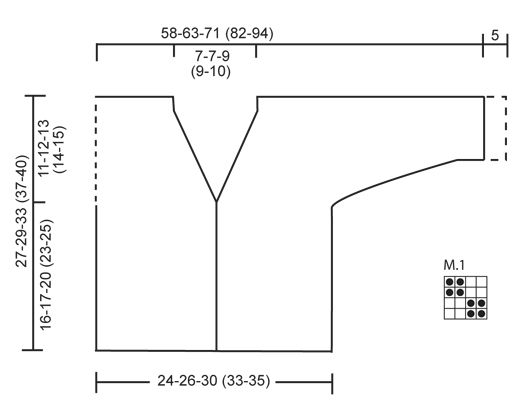 |
|||||||
Avete terminato questo modello?Allora taggate le vostre foto con #dropspattern #checcosdreamcardigan o inviatele alla #dropsfan gallery. Avete bisogno di aiuto con questo modello?Troverete 15 video tutorial, una sezione per i commenti/domande e molto altro guardando il modello su www.garnstudio.com © 1982-2025 DROPS Design A/S. Ci riserviamo tutti i diritti. Questo documento, compreso tutte le sue sotto-sezioni, è protetto dalle leggi sul copyright. Potete leggere quello che potete fare con i nostri modelli alla fine di ogni modello sul nostro sito. |
|||||||








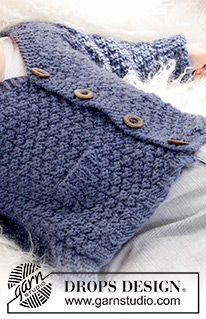

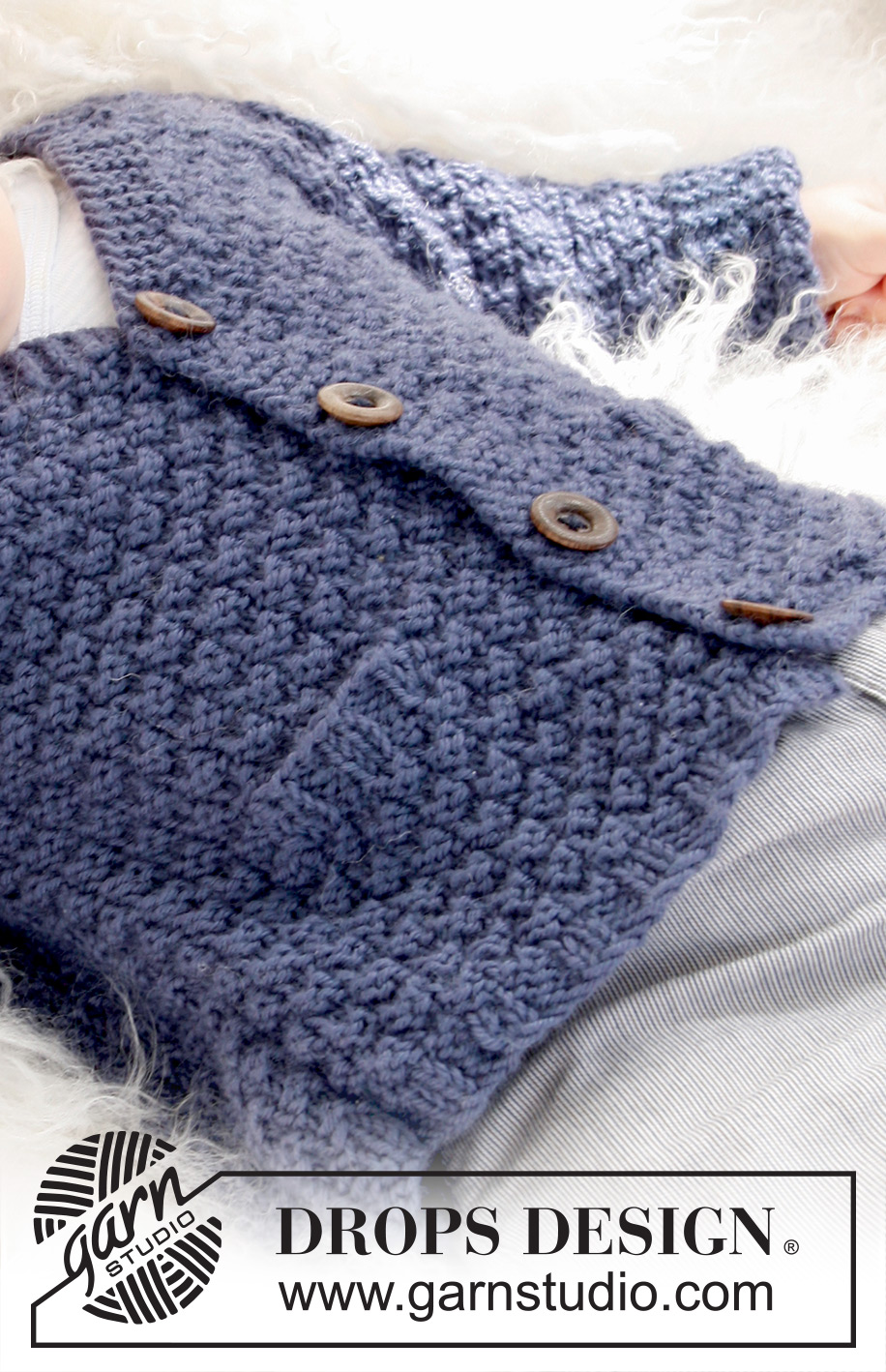

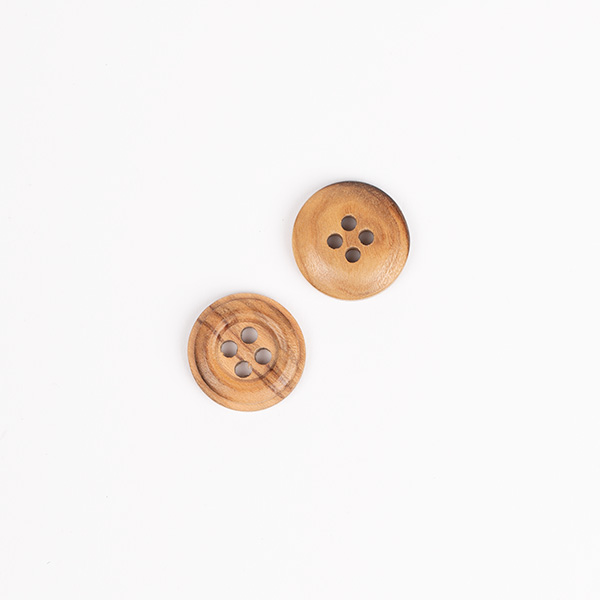

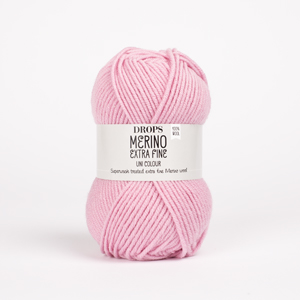
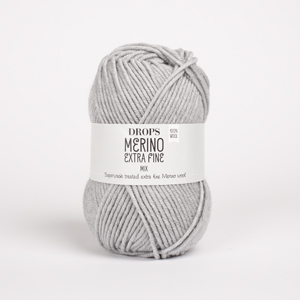










































Lasciare un commento sul modello DROPS Baby 21-11
Noi saremmo felici di ricevere i tuoi commenti e opinioni su questo modello!
Se vuoi fare una domanda, fai per favore attenzione a selezionare la categoria corretta nella casella qui sotto per velocizzare il processo di risposta. I campi richiesti sono indicati da *.